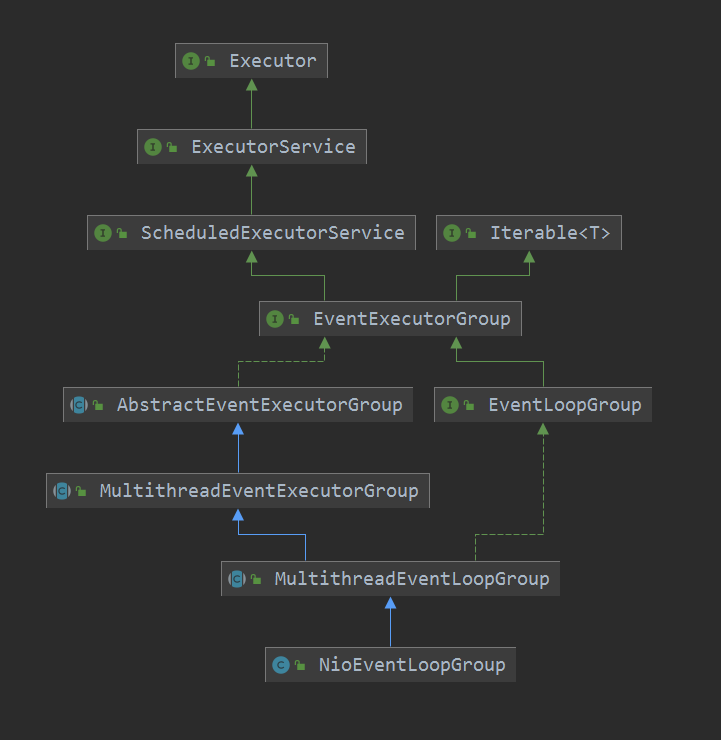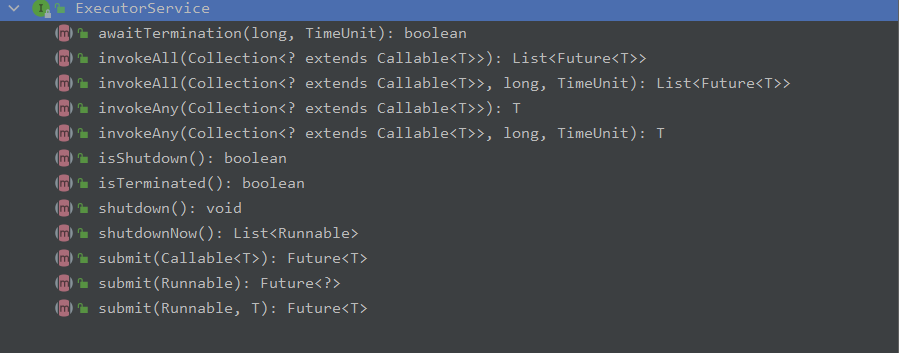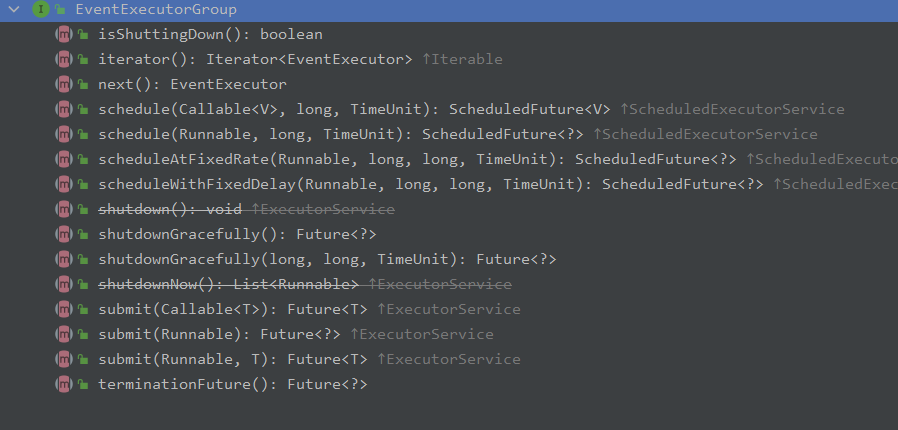NioEventLoopGroup 源码解析
本文中 netty 采用的版本为 4.1.66.Final-SNAPSHOT。NioEventLoopGroup 的类图如下所示:
Executor
JDK中定义的接口,线程执行器,主要用来控制线程的启动、执行和关闭,可以简化并发编程的操作,只定义了一个方法。
void execute(Runnable command);
ExecutorService
JDK中定义的接口,扩展了Executor的功能,提供了生命周期管理的方法,返回 Future 对象。
ScheduledExecutorService
JDK中定义的接口,扩展了ExecutorService,用于线程任务的定时或者延期执行。
EventExecutorGroup
接口,继承了ScheduledExecutorService 和 Iterator,因此具备了线程和iterator最基本的方法,同时定义了关闭线程、释放线程资源的优雅方法。
EventLoopGroup
接口,定义了注册channel到EventLoop方法,注册完成后会收到通知,返回的是ChannelFuture。
public interface EventLoopGroup extends EventExecutorGroup {
/**
* Return the next {@link EventLoop} to use
*/
@Override
EventLoop next();
/**
* Register a {@link Channel} with this {@link EventLoop}. The returned {@link ChannelFuture}
* will get notified once the registration was complete.
*/
ChannelFuture register(Channel channel);
/**
* Register a {@link Channel} with this {@link EventLoop} using a {@link ChannelFuture}. The passed
* {@link ChannelFuture} will get notified once the registration was complete and also will get returned.
*/
ChannelFuture register(ChannelPromise promise);
/**
* Register a {@link Channel} with this {@link EventLoop}. The passed {@link ChannelFuture}
* will get notified once the registration was complete and also will get returned.
*
* @deprecated Use {@link #register(ChannelPromise)} instead.
*/
@Deprecated
ChannelFuture register(Channel channel, ChannelPromise promise);
}
AbstractEventExecutorGroup
抽象类,EventExecutorGroup 的默认实现类,对线程任务的定时和延期执行方法具体实现。
public abstract class AbstractEventExecutorGroup implements EventExecutorGroup {
@Override
public Future<?> submit(Runnable task) {
return next().submit(task);
}
@Override
public <T> Future<T> submit(Runnable task, T result) {
return next().submit(task, result);
}
@Override
public <T> Future<T> submit(Callable<T> task) {
return next().submit(task);
}
@Override
public ScheduledFuture<?> schedule(Runnable command, long delay, TimeUnit unit) {
return next().schedule(command, delay, unit);
}
@Override
public <V> ScheduledFuture<V> schedule(Callable<V> callable, long delay, TimeUnit unit) {
return next().schedule(callable, delay, unit);
}
@Override
public ScheduledFuture<?> scheduleAtFixedRate(Runnable command, long initialDelay, long period, TimeUnit unit) {
return next().scheduleAtFixedRate(command, initialDelay, period, unit);
}
@Override
public ScheduledFuture<?> scheduleWithFixedDelay(Runnable command, long initialDelay, long delay, TimeUnit unit) {
return next().scheduleWithFixedDelay(command, initialDelay, delay, unit);
}
@Override
public Future<?> shutdownGracefully() {
return shutdownGracefully(DEFAULT_SHUTDOWN_QUIET_PERIOD, DEFAULT_SHUTDOWN_TIMEOUT, TimeUnit.SECONDS);
}
@Override
public <T> List<java.util.concurrent.Future<T>> invokeAll(Collection<? extends Callable<T>> tasks)
throws InterruptedException {
return next().invokeAll(tasks);
}
@Override
public <T> List<java.util.concurrent.Future<T>> invokeAll(
Collection<? extends Callable<T>> tasks, long timeout, TimeUnit unit) throws InterruptedException {
return next().invokeAll(tasks, timeout, unit);
}
@Override
public <T> T invokeAny(Collection<? extends Callable<T>> tasks) throws InterruptedException, ExecutionException {
return next().invokeAny(tasks);
}
@Override
public <T> T invokeAny(Collection<? extends Callable<T>> tasks, long timeout, TimeUnit unit)
throws InterruptedException, ExecutionException, TimeoutException {
return next().invokeAny(tasks, timeout, unit);
}
@Override
public void execute(Runnable command) {
next().execute(command);
}
}
MultithreadEventExecutorGroup
抽象类,多线程事件循环执行器池,继承了AbstractEventExecutorGroup,维护了一个EventExecutor数组,管理多线程,定义了一些 EventExecutor 数组的操作方法。
主要在这个构造器中进行功能实现,调用子类
NioEventLoopGroup中的newChild方法。
/**
* Create a new instance.
*
* @param nThreads the number of threads that will be used by this instance.
* @param executor the Executor to use, or {@code null} if the default should be used.
* @param chooserFactory the {@link EventExecutorChooserFactory} to use.
* @param args arguments which will passed to each {@link #newChild(Executor, Object...)} call
*/
protected MultithreadEventExecutorGroup(int nThreads, Executor executor,
EventExecutorChooserFactory chooserFactory, Object... args) {
// 检查线程数量>0
checkPositive(nThreads, "nThreads");
// 如果执行器为空,则创建一个
if (executor == null) {
// 线程优先策略,采用默认优先级5,最小优先级1,最大优先级10
executor = new ThreadPerTaskExecutor(newDefaultThreadFactory());
}
// 执行器数组大小为给定的线程数量
children = new EventExecutor[nThreads];
for (int i = 0; i < nThreads; i ++) {
boolean success = false;
try {
// 调用子类创建执行器的方法,创建多线程
children[i] = newChild(executor, args);
success = true;
} catch (Exception e) {
// TODO: Think about if this is a good exception type
throw new IllegalStateException("failed to create a child event loop", e);
} finally {
// 创建失败,则释放执行器数组内的线程资源
if (!success) {
for (int j = 0; j < i; j ++) {
children[j].shutdownGracefully();
}
for (int j = 0; j < i; j ++) {
EventExecutor e = children[j];
try {
while (!e.isTerminated()) {
e.awaitTermination(Integer.MAX_VALUE, TimeUnit.SECONDS);
}
} catch (InterruptedException interrupted) {
// Let the caller handle the interruption.
Thread.currentThread().interrupt();
break;
}
}
}
}
}
/**
* 选择器,根据执行器数据长度确定如何挑选,默认实现为DefaultEventExecutorChooserFactory
* 采用策略者模式:如果是2的指数倍, 返回 PowerOfTwoEventExecutorChooser,否则返回 GenericEventExecutorChooser
*/
chooser = chooserFactory.newChooser(children);
// 创建线程停止监听器
final FutureListener<Object> terminationListener = new FutureListener<Object>() {
@Override
public void operationComplete(Future<Object> future) throws Exception {
if (terminatedChildren.incrementAndGet() == children.length) {
terminationFuture.setSuccess(null);
}
}
};
// 为每个执行器添加线程停止监听
for (EventExecutor e: children) {
e.terminationFuture().addListener(terminationListener);
}
Set<EventExecutor> childrenSet = new LinkedHashSet<EventExecutor>(children.length);
Collections.addAll(childrenSet, children);
// 只读事件实例化,返回指定集合的不可修改集合,这种方法允许模块为用户提供对内部集合的“只读”访问
readonlyChildren = Collections.unmodifiableSet(childrenSet);
}
MultithreadEventLoopGroup
抽象类,多线程事件循环池,EventLoopGroup 实现的抽象基类,同时继承了MultithreadEventExecutorGroup,可同时处理多个线程的任务。
- 设置了默认线程数为
cup核心 * 2``` java static { DEFAULT_EVENT_LOOP_THREADS = Math.max(1, SystemPropertyUtil.getInt( “io.netty.eventLoopThreads”, NettyRuntime.availableProcessors() * 2));
if (logger.isDebugEnabled()) {
logger.debug("-Dio.netty.eventLoopThreads: {}", DEFAULT_EVENT_LOOP_THREADS);
}
} ```
- 重写父类
MultithreadEventExecutorGroup的默认线程工厂方法,父类方法线程正常优先级5,重写后为最大优先级10。
@Override
protected ThreadFactory newDefaultThreadFactory() {
return new DefaultThreadFactory(getClass(), Thread.MAX_PRIORITY);
}
- 实现接口
EventLoopGroup定义的注册channel方法,EventLoop处理channel注册后的所有I/O操作。
@Override
public EventLoop next() {
return (EventLoop) super.next();
}
@Override
public ChannelFuture register(Channel channel) {
return next().register(channel);
}
@Override
public ChannelFuture register(ChannelPromise promise) {
return next().register(promise);
}
NioEventLoopGroup
普通类,具体实现了MultithreadEventExecutorGroup中的newChild方法,最后调用new NioEventLoop创建NioEventLoop,同时增加了setIoRatio 和 rebuildSelectors 方法。
/**
* 重写创建执行器方法,继承自父类MultithreadEventLoopGroup的父类MultithreadEventExecutorGroup中的方法
* 无参的构造器NioEventLoopGroup()调用方式:
* ==> 1.
* ==> nThread为0,
* ==> executor为null,
* ==> 选择器策略为默认 DefaultSelectStrategyFactory.INSTANCE
* ==> RejectedExecutionHandler为 reject()(即直接抛异常)
* ==> 2.
* ==> 先调用父类 MultithreadEventLoopGroup 构造器,线程数初始化线程数为 cpu核心 * 2
* ==> 3.
* ==> MultithreadEventLoopGroup 再调用父类 MultithreadEventExecutorGroup 构造器,new ThreadPerTaskExecutor,
* ==> 4.
* ==> 调用子类 NioEventLoopGroup的 newChild 方法
*
* @param executor
* @param args
* @return
* @throws Exception
*/
@Override
protected EventLoop newChild(Executor executor, Object... args) throws Exception {
// 1 selector 工厂方法,根据系统属性java.nio.channels.spi.SelectorProvider ,调用反射获取
// 2 ServiceLoader 采用spi获取,这里采用的方式和jdk中的selector策略一样
// 3 采用默认的selectorProvider:DefaultSelectorProvider==> WindowsSelectorProvider==> WindowsSelectorImpl
SelectorProvider selectorProvider = (SelectorProvider) args[0];
// selector策略工厂方法
SelectStrategyFactory selectStrategyFactory = (SelectStrategyFactory) args[1];
// 执行器拒绝策略
RejectedExecutionHandler rejectedExecutionHandler = (RejectedExecutionHandler) args[2];
// 任务队列工厂方法
EventLoopTaskQueueFactory taskQueueFactory = null;
// 尾部任务队列工厂方法
EventLoopTaskQueueFactory tailTaskQueueFactory = null;
int argsLength = args.length;
if (argsLength > 3) {
taskQueueFactory = (EventLoopTaskQueueFactory) args[3];
}
if (argsLength > 4) {
tailTaskQueueFactory = (EventLoopTaskQueueFactory) args[4];
}
return new NioEventLoop(this, executor, selectorProvider,
selectStrategyFactory.newSelectStrategy(),
rejectedExecutionHandler, taskQueueFactory, tailTaskQueueFactory);
}
设置子事件循环中用于 I/O 的所需时间量的百分比,默认50,是在NioEventLoop中定义的。
/**
* Sets the percentage of the desired amount of time spent for I/O in the child event loops. The default value is
* {@code 50}, which means the event loop will try to spend the same amount of time for I/O as for non-I/O tasks.
*/
public void setIoRatio(int ioRatio) {
for (EventExecutor e: this) {
((NioEventLoop) e).setIoRatio(ioRatio);
}
}
解决 Linux 的epoll模式 100% CPU 错误问题。
/**
* Replaces the current {@link Selector}s of the child event loops with newly created {@link Selector}s to work
* around the infamous epoll 100% CPU bug.
*/
public void rebuildSelectors() {
for (EventExecutor e: this) {
((NioEventLoop) e).rebuildSelector();
}
}




